EQ can export accounts data in file formats that are appropriate for importing into Sage Cloud Accounting, amongst other accounts software.
For Sage desktop software instructions click here.
Considerations before you export:
•You can export 3 analysis fields to Sage with invoices. You can decide if this should be classifications such as customer type, showroom/branch, or sales person.
•One of the fields to export is the tax description. To match the text of the description exactly as Sage requires, you may need to go in to EQ's Customise > Currency/Tax Settings and overtype the descriptions shown here:
e.g. "Standard rate transactions" may need to just be "Standard" for Sage to import correctly.
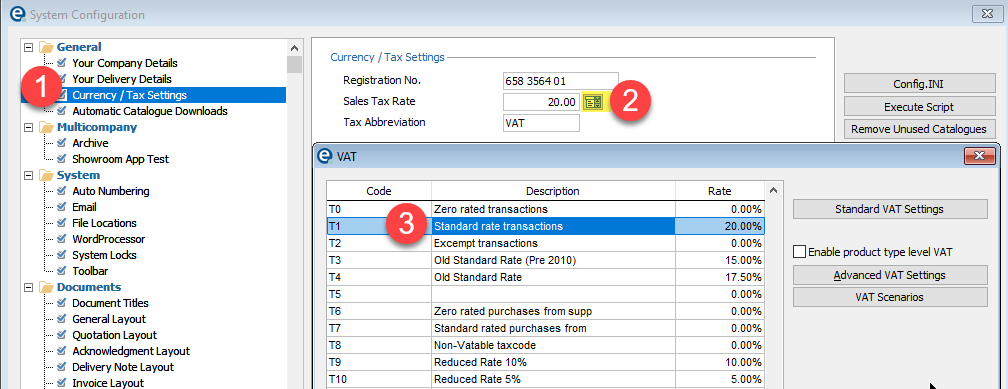
Exporting Sales Invoices
1.Within EQ open Projects > Invoices
2.Use Filter List to apply filter criteria, for example invoice dates.
For subsequent exports you will likely want to include the option "Exclude invoices exported to accounts" as shown below. This will ensure you will only export each invoice once
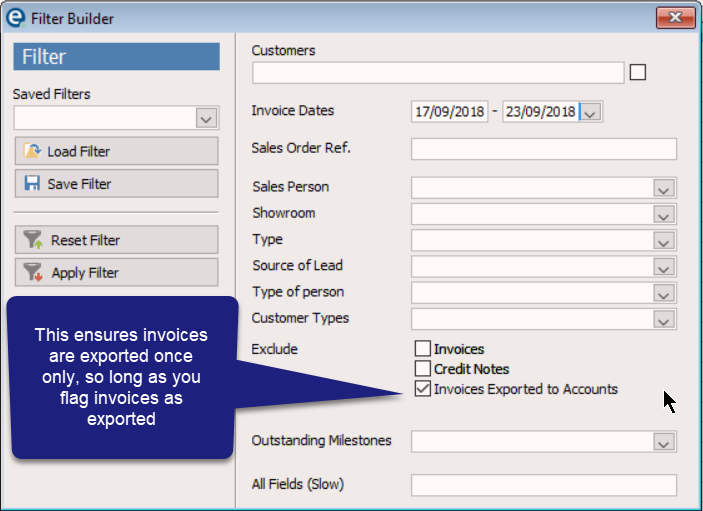
3.Once you have filtered your list, click Invoices on the top menu bar and pick Export Invoice List [CSV] as below:
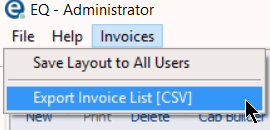
4.The first time you export you will need to select the fields you want to export. Follow the steps below to select the commonly used fields. You may adjust these to suit your purposes:
a) Tick Include Header (ticking Open file after export is optional, if you would like to see the data before importing to Sage)
b) Tick "Flag as Exported to Accounts" (so next time you filter, EQ knows which invoices have already been exported)
c) Tick "Export Credits as a positive value" (Sage uses the "type" to determine invoice or credit, not the value)
d) Tick the fields as per the list below, setting the Header and Sequence exactly as the list.
This is a common format for Sage Accounting (cloud based) but may be adjusted if you are instructed in other compatible files by Sage support or documentation. Note that these fields make assumptions about how you will show your data in Sage.
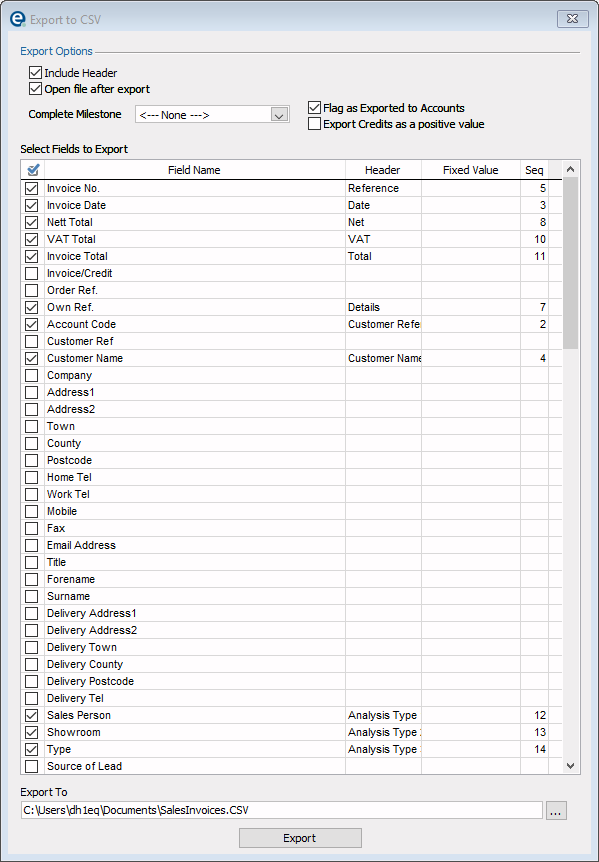
Field Name in EQ |
Header for Sage |
Seq |
Invoice No. |
Reference |
5 |
Invoice Date |
Date |
3 |
Nett Total |
Net |
8 |
VAT Total |
VAT |
10 |
Invoice Total |
Total |
11 |
Own Ref. |
Details |
7 |
Account Code |
Customer Reference |
2 |
Customer Name |
Customer Name |
4 |
Sales Person |
Analysis Type 1 |
12 |
Showroom |
Analysis Type 2 |
13 |
Type |
Analysis Type 3 |
14 |
Room Type Sales Nominal |
Ledger Account |
6 |
Tax Description |
VAT Rate |
9 |
Invoice/Cr Note |
Type |
1 |
For additional information on the format required by Sage Accounting in the cloud, please view this Sage help article "Quick entry import" and contact Sage support.
You may wish to setup 3 other fields for Analysis types 1, 2 and 3 depending on the data you wish to store in Sage. The 3 above are suggested defaults.
Note on 'Fixed' fields. These are blank fields where you can either leave empty to create a blank column on the export file, or enter some text which will always appear on every line, e.g. qty is fixed to 1.
5.Under Export To click the ... button to select the folder on your PC or network where you need to save the export file.
You have now completed the sales invoices export, ready to be imported to Sage Accounting.
Export Purchase Invoices
1. Within EQ open Projects > Invoices
2. Use Filter List to apply filter criteria, for example invoice dates or export dates.
3. For subsequent exports you will likely want to include the option to exclude "Invoices Exported to Accounts" as shown below. This will ensure you will only export each invoice once

4. Once you have filtered the list, click Purchase Invoices at the top of the screen and select Export Purchase Order List [CSV]

5. The first time you export you will need to select the fields you want to export:
a) Tick Include Header (ticking Open file after export is optional, if you would like to see the data before importing to Sage)
b) Tick "Flag as Exported to Accounts" (so next time you filter, EQ knows which invoices have already been exported)
c) Tick "Export Credits as a positive value" (Sage uses the "type" to determine invoice or credit, not the value)
d) Tick the fields as per the list below, setting the Header and Sequence exactly as the list.
This is a common format for Sage but may be adjusted if you are instructed in other compatible files by Sage support or documentation. Note that these fields make assumptions about how you will show your data in Sage.
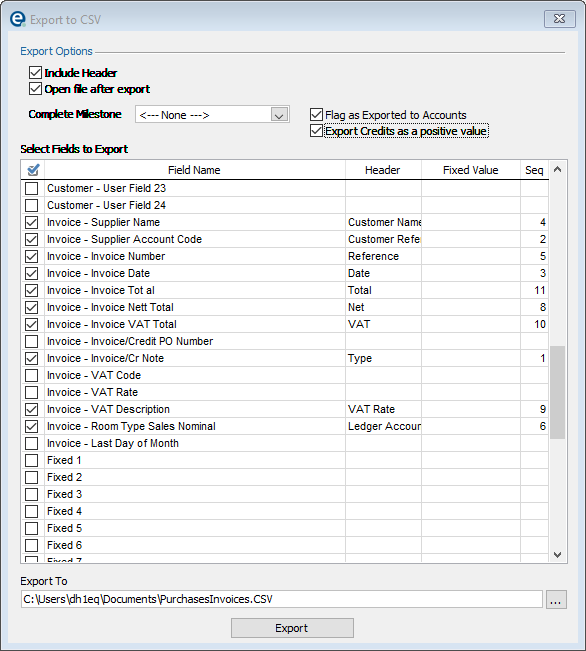
Field Name in EQ |
Header for Xero |
Seq |
Order - Own Ref |
Details |
7 |
Invoice - Supplier Name |
Customer Name |
4 |
Invoice - Supplier Account Number |
Customer Reference |
2 |
Invoice - Invoice Number |
Reference |
5 |
Invoice - Invoice Date |
Date |
3 |
Invoice - Invoice Total |
Total |
11 |
Invoice - Invoice Nett Total |
Net |
8 |
Invoice - Invoice VAT Total |
VAT |
10 |
Invoice - Invoice/Cr Note |
Type |
1 |
Invoice - VAT Description |
VAT Rate |
9 |
Invoice - Room Type Sales Nominal |
Ledger Account |
6 |
b) Under Export To click the ... button to select the folder on your PC or network where you need to save the export file.
You have now completed the sales invoices export, ready to be imported to Sage accounts.
For additional information on the format required by Sage Accounting in the cloud, please view this Sage help article "Quick entry import" and contact Sage support.
You may wish to setup 3 other fields for Analysis types 1, 2 and 3 depending on the data you wish to store in Sage. The 3 above are suggested defaults.